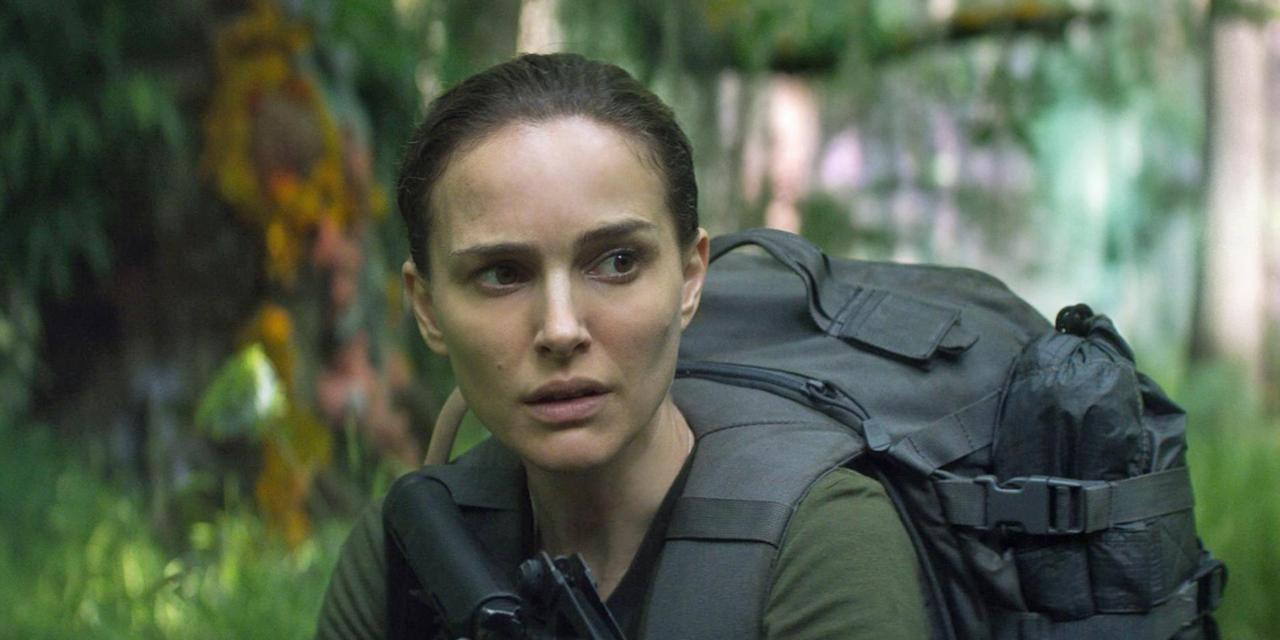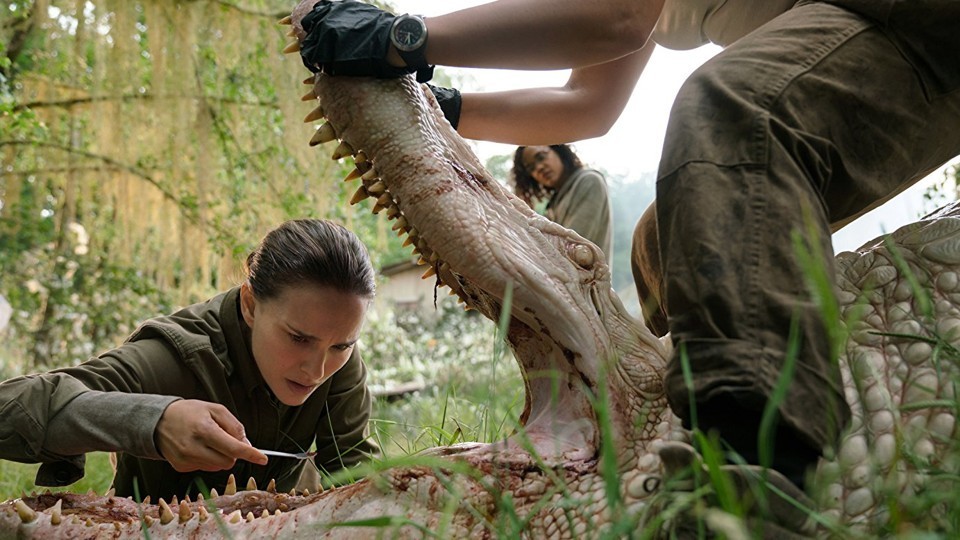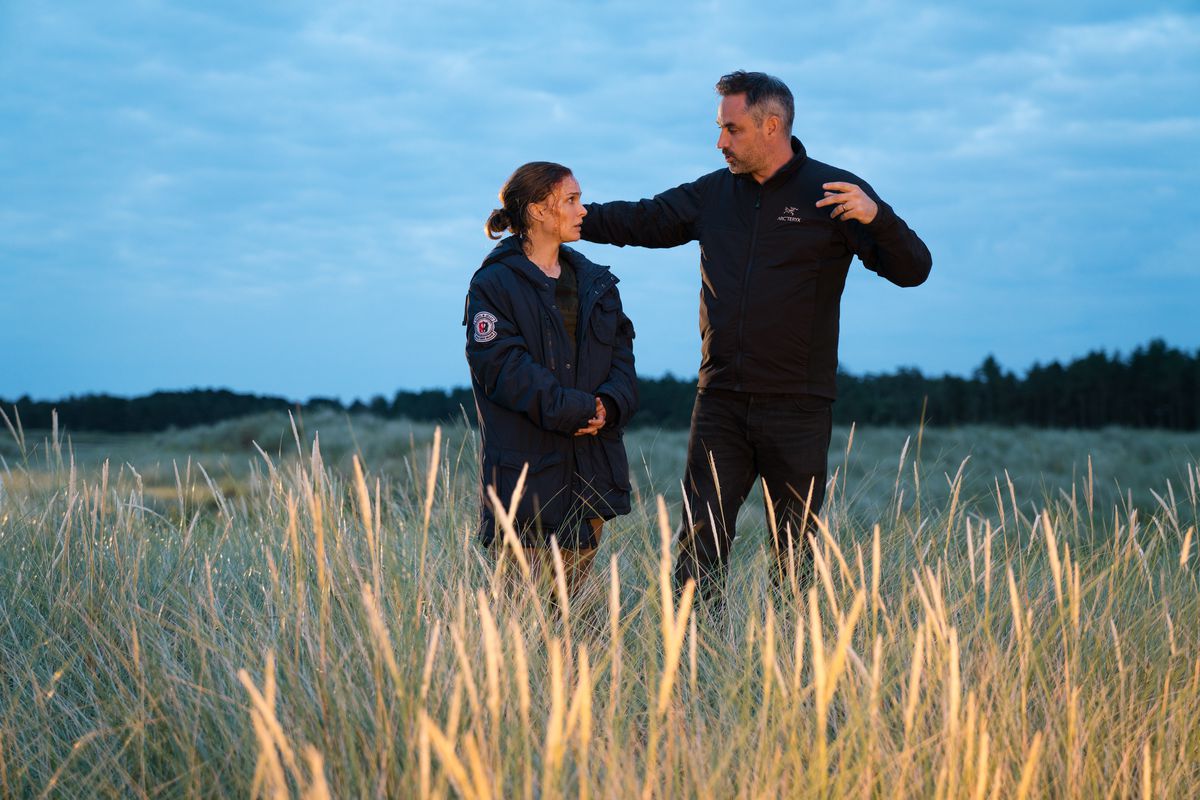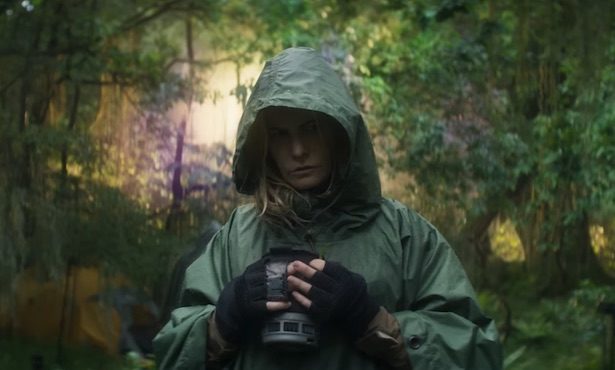
Profoundly unsettling and endlessly imaginative, Alex Garland’s Annihilation, adapted from the first book in Jeff VanderMeer’s brilliant best-selling “Southern Reach Trilogy” (2014), presents adventurous viewers with a frequently hypnotic and sporadically heady miscellany of grandiose ecological parable and nerve-racking survival tale in deep sci-fi accouterment.
Lena (Natalie Portman), a grieving biology professor and former U.S. Army soldier, is part of an all-female reconnaissance outfit sent into a top secret stretch of North American coast where something alien has altered the environment and nature has gone berserk; plantlife has grown into gorgeous and sinister floral forms and humanlike shapes; mutated beats, some seeming prehistoric, others like a Miyazaki fever dream, travel the timbers and marshlands down the coast.
This environmental territory, with startling shades of Chernobyl and Fukushima Daiichi, is in a frightening flux as its boundaries keep mushrooming. Lena and the rest of her unit, not at all the first reconnaissance team to lose their way trying to penetrate this strange southern zone, not only find that their GPS signals and other communications and tracking devices are affected by their environment, but also startlingly realize that their mental and emotional faculties are also socked in and uncertain.
The following list will detail, debate, and celebrate why it is that Garland’s second film as director ranks amongst the 21st century’s most mesmerizing and upsetting speculative fictions. Annihilation is a film that belongs on a very short list of incalculably ambitious, deeply thoughtful, teasingly ambiguous, hugely rewarding, and highly artistic sci-fi endeavors, standing shoulder to shoulder with lasting works like Stanley Kubrick’s 2001: A Space Odyssey (1968), Rainer Werner Fassbinder’s World on a Wire (1973), and Andrei Tarkovsky’s Stalker (1979).
Annihilation is a world of weird fiction; of dead husbands and daughters, of doppelgängers, waking dreams, monstrous rogue bears capable of ghastly human mimicry, mutated hyacinths that scion to the skin, and far more menacing eventualities that disquiet and demolish the human mind.
Be warned, there are some spoilers ahead, though we’ve taken pains not to totally reveal the many mysterious that Annihilation observes, obscures, and reveals. Enjoy!
9. It’s adapted from strong source material

For a number of years now, award-winning American author Jeff VanderMeer (dubbed the “King of Weird Fiction”) has been carving his own little niche in the new weird literary genre –– an amalgam of horror and speculative fiction –– with celebrated works such as his fantasy short story anthology “City of Saints and Madmen: The Book of Ambergris” (2001), his WTF uncompromising 2014 genre series the “Southern Reach Trilogy” (the first book of which Annihilation comes from), and his more recent 2017 “biotech apocalypse” novel, Borne (my personal favorite of his, so far).
VanderMeer’s difficult to categorize work, which has garnered him comparisons to Argentine magical realist Jorge Luis Borges, and American naturalist and philosopher Henry David Thoreau, have helped to establish him as an impressive and important writer. It’s not surprising that a filmmaker and former novelist like Alex Garland, would be drawn to the dark and detailed worlds that VanderMeer creates.
At an important turning point in the film, Josie Radek (Tessa Thompson), the physicist of the team, has a realization and reveals that the Shimmer seems to refract everything in its environment, from daylight to soundwaves, to the genetic coding in plant, animal, and potentially even human life. And this refraction also represents how Garland’s adaptation refracts the source novel.
Lovers of VanderMeer’s book will have to wrestle with a certain degree of alienation and upset in that we never get to see the Crawler, explore the Tower, shiver at the startling cursive concerning “Where lies the strangling fruit…”, or explore the upper levels of the lighthouse, or other nuances and character flourishes that the novel so boldly detailed. Instead we get a different but no less compelling beast that still froths and sneers with VanderMeer’s themes and ideas while inventing many memorable ones of his own (more on those later on down this list).
In many publicity interviews for Annihilation, as in the one with Creative Screenwriting, Garland reiterates that “…at the point I started working on Annihilation, there was only one of the three books. I knew that it was planned as a trilogy by the author, but there was only the manuscript for the first book. I really didn’t think too much about the trilogy side of it.” So, with reverence to VanderMeer’s story and the strong cosmology therein, Garland created his own world as “an adaptation which was a memory of the book.”
8. Alex Garland as author turned director

It’s worth noting, particularly given the literary origins and high-flown philosophy at the crux of Annihilation, that Garland isn’t just a writer turned writer-director but rather a novelist turned filmmaker.
Garland’s 1996 novel “The Beach” became something of a cult classic and Nick Hornby dubbed it “a ‘Lord of the Flies’ for Generation X” and was soon adapted by Garland, for Danny Boyle’s 2000 film, starring Leonardo DiCaprio. Garland followed “The Beach” with his non-linear narrative novel from 1998, “The Tesseract” (which also received a film adaptation, in 2003 by Oxide Pang).
While Garland’s success as a novelist lead to his two celebrated collaborations with Boyle (Garland’s screenplays for 28 Days Later [2002], and Sunshine [2007], respectively) and several other strong genre scripts (Never Let Me Go [2010], and Dredd [2012] being the most notable), before his dazzling writer-director debut Ex Machina (2015), it was always apparent that this was an artist with a true storyteller’s gift for keeping the action explicit and exciting while steadily moving forward with surety and tact.
Audiences and critics agree that Garland’s Annihilation can suitably be measured next to the not dissimilar psychological sci-fi spectacle of Stanley Kubrick’s 2001: A Space Odyssey (adapted rather proximately from Arthur C. Clarke’s 1948 short story “The Sentinel”) and Andrei Tarkovsky’s ambiguous arthouse epic Stalker (very loosely adapted from Boris and Arkady Strugatsky’s 1972 novel “Roadside Picnic”). And it must be said that Garland can stand these comparisons and still remain his own man.
Garland’s deliberate ambiguity and obscurity in Annihilation is no mere pretense or masquerade for foggy, half-realized purposes or visual concepts. Where Stalker seemed to augur if not summon Chernobyl, Annihilation “refracts” Fukushima. Humanity may routinely wrong nature, but with Garland’s film we see the inherent risks. And where 2001’s “Star Child” represents a future stage of evolution, Garland gives us an interpretation of death’s potential dignity and the trust of noble transfiguration.
7. The score by Ben Salisbury and Geoff Barrow

Wisely reuniting his Ex Machina composers to score Annihilation, Ben Salisbury (a veteran composer, best known for his work in film and TV) and Geoff Barrow (whose fame as film composer is only rivalled by his brilliant career in the legendary trip hop band Portishead) make a truly dynamic duo.
Where Ex Machina’s memorable score was soaked in atmospheric synths within a minimalist sphere, perfect for the claustrophobic elements of that film, for Annihilation both Barrow and Salisbury sought for an delivered a much more encompassing and expansive sound.
Deliberately making sounds identifiably human and altogether alien, the mind-altering and at times utterly psychedelic soundscapes these two have crafted offer a wide range; from acoustic guitar, orchestral flourish, to synth-saturated climes that work through a four-note motif that gets scary when it has to (particularly during the film’s intense extended climax and gripping closing coda).
6. The look of the film and the Shimmer itself

Certainly when showcasing a startling cosmology with similarities and deviences to our own, it works to the film’s advantage to have a gifted team capable of conveying the director’s vision.
And so it’s no surprise that Garland’s crew, many whom he worked with on Ex Machina, all bring their A game with them; cinematographer Rob Hardy (2007’s Boy A, Ex Machina), production designer Mark Digby, and visual effects supervisor Andrew Whitehurst are amongst the creatives on behalf of Garland, each displaying amongst their finest work to date. And perhaps what’s most memorable in Annihilation, from a visual perspective, is the strange aura that envelopes the characters once they enter the Shimmer.
At first the Shimmer appears to the viewer as a wall of eerie, emulated light, glimpsed from Area X, surrounding the inland border. It glows and trembles, creating a rainbow-tinged twilight, streaked with constantly changing and rather subtle patterning, not unlike a diesel spill in rainwater or the colorful prism from a rainbow. And then when we go beyond the scrim, the forest within is almost drowned in equally intense and yet also hazy colors.
Early on within the Shimmer, Lena points out how a vast array of varying flowers all somehow come from the same plant like crazy bouquets. This is a recurring motif throughout the Shimmer; an enormous alligator shows concentric rows of teeth from other specie;, lichens and moss are brightly colored and creepy as a result; trees and shrubs that appear to be the work of a topiary genius; frighteningly have grown into human-like form (shaped by human Hox genes, as Tessa Thompson’s physicist tells us).
As Annihilation progresses, the ghostly prism refraction follows our characters almost everywhere, and the familiar aspects of nature take on mutations both subtle and extreme that help flesh out this strange and stunning world.